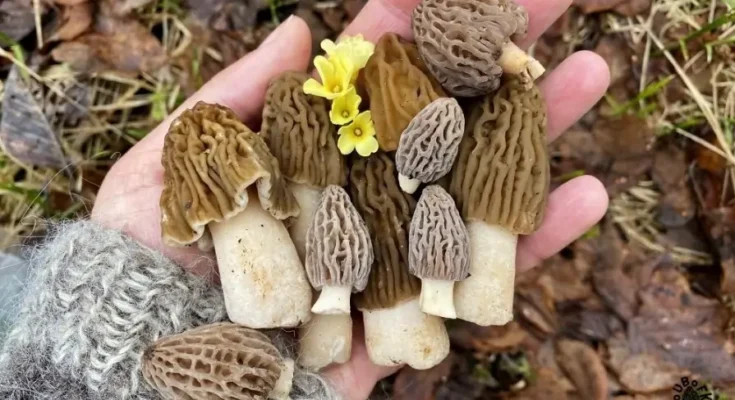Morel mushrooms are a coveted delicacy in the world of gourmet cuisine, celebrated for their unique appearance, rich flavor, and versatility in cooking. However, these fascinating fungi aren’t just a treat for the palate—they also boast a wealth of health benefits and have been used in traditional medicine for centuries. In this article, we’ll explore the different types of morel mushrooms, their health benefits, and the crucial safety guidelines for harvesting and consuming them.
What Are Morel Mushrooms?
Morel mushrooms (genus Morchella) are a group of edible fungi known for their distinctive honeycomb-like appearance. Their caps are pitted and cone-shaped, which makes them easily recognizable to foragers. The cap is typically attached directly to the stem, unlike other mushrooms where the cap is separate from the stalk.
Morels are often found in forests, near riverbanks, and in areas with moist, well-drained soil. They have a short growing season in spring, which makes them a highly sought-after mushroom by both professional chefs and amateur foragers.
Different Types of Morel Mushrooms
There are several species of morel mushrooms, but the most commonly encountered varieties include:
- Yellow Morel (Morchella esculenta)
One of the most popular and widespread species, yellow morels are often the first to appear during the spring months. They have a light yellow to golden-brown color and are known for their delicate, earthy flavor. - Black Morel (Morchella elata)
Black morels are typically darker in color, ranging from deep brown to black, and are often more prized by mushroom hunters due to their rich, robust flavor. They are generally found in slightly more arid regions and can grow in association with forest fires. - White Morel (Morchella deliciosa)
White morels are rare and often regarded as a delicacy due to their subtle flavor and creamy texture. They are typically found in woodlands and thrive in areas with moist, loamy soil. - Half-Free Morel (Morchella punctipes)
As the name suggests, the cap of the half-free morel is only partially attached to the stem, creating a more open appearance. It is found in woodland environments and is often smaller than other species of morels. - Gray Morel (Morchella angusticeps)
A less common variety, gray morels are similar to black morels in appearance but tend to have a lighter shade and a slightly milder flavor. They are typically found in sandy soils and forested areas.
Nutritional Benefits of Morel Mushrooms
Morel mushrooms are not only prized for their flavor but also for their nutritional profile. Packed with essential vitamins, minerals, and antioxidants, they offer a variety of health benefits.
- Rich in Protein
Morels are an excellent source of plant-based protein, which is beneficial for vegetarians and vegans looking to increase their protein intake. Protein is vital for muscle repair, immune function, and overall body maintenance. - High in Vitamins and Minerals
Morels contain a range of important vitamins and minerals, including Vitamin D, B vitamins (such as B2 and B3), potassium, copper, and iron. These nutrients support various bodily functions, from bone health to energy production and red blood cell formation. - Rich in Antioxidants
The antioxidants found in morel mushrooms—such as polyphenols—help protect cells from oxidative damage, which can contribute to aging and the development of chronic diseases. Regular consumption of morels may help boost the body’s ability to fight free radicals. - Low in Calories and Fat
Morels are naturally low in calories and contain minimal fat, making them an excellent food choice for those looking to maintain or lose weight without sacrificing nutritional value. Their high fiber content also promotes healthy digestion and satiety. - Potential Anti-Inflammatory Properties
Some studies suggest that morel mushrooms possess anti-inflammatory properties, which can support the immune system and may contribute to reducing inflammation in the body.
How to Safely Harvest and Consume Morel Mushrooms
While morel mushrooms offer many benefits, it’s essential to exercise caution when harvesting and consuming them. There are a few key safety considerations to keep in mind:
1. Toxic Lookalikes
The most important safety tip when foraging for morel mushrooms is to be aware of toxic lookalikes. One common species to avoid is the Gyromitra mushroom, often referred to as the “false morel.” False morels can be poisonous, containing a toxin called hydrazine that can cause serious illness or even death if consumed.
Key differences to look for:
- Morels have a cap that is attached to the stem, while false morels often have a loosely hanging or “free” cap.
- Morel caps are honeycomb-shaped, whereas false morel caps are typically irregular and lobed.
To ensure safety, always consult an expert or use a reliable field guide when identifying morel mushrooms. If you’re not completely sure about a mushroom’s identity, it’s best to err on the side of caution and avoid eating it.
2. Proper Cooking
Morel mushrooms should never be eaten raw, as they contain trace amounts of toxins that are broken down during cooking. Always cook morels thoroughly by sautéing, grilling, or simmering them. Most recipes for morels call for cooking them in butter, cream, or broth to bring out their rich flavors.
Cooking tips:
- Clean them thoroughly: Morels are known to trap dirt and insects within their honeycomb-like structure, so rinse them gently under cold water to remove any debris.
- Slice them in half: Larger morels should be cut in half lengthwise to ensure even cooking and to check for any insects inside.
3. Moderation is Key
While morel mushrooms are safe to eat when properly prepared, it’s important to consume them in moderation. Excessive consumption can lead to digestive issues or mild toxicity, especially if the mushrooms are not cooked properly.



